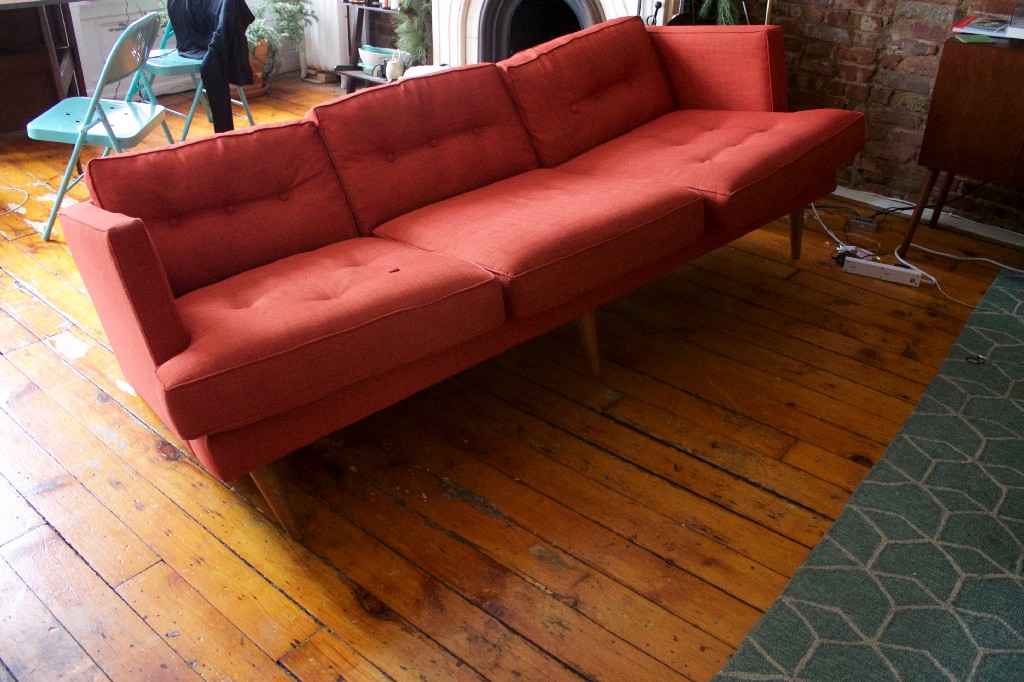Why Does This One Couch From West Elm Suck So Much?
Comparing notes with other unsatisfied owners of the Peggy sofa

When I was a kid my grandma had a couch on her front porch that was, as a result of some sort of thrifty post-wartime craft project, stuffed with crumpled-up newspapers. Every couch I have sat on since then has felt unreasonably, needlessly luxurious. Poly-Fil? Foam? Goose feathers? Forget about it. The only couch anybody needs is a metal frame pulled from the curb, a few pillow cases, and a stack of old newspapers.
But in spite of myself, as a 28-year-old, I find myself drawn into the same capitalistic pitfall that many young professionals are drawn into — a need to prove my adulthood with mid-century furniture. And more specifically, a need to prove that I’ve graduated from Walmart bedframes and second-hand plywood shelves scooped up from the sidewalk.
This is why, a few weeks after moving in with my partner, Kevin, we decided to buy a couch from West Elm. The couch would be the most prominent piece of furniture in our small apartment and our first big purchase together — a gigantic spongy representation of our shared style sensibility. We chose a West Elm design called the “Peggy” in a deep rusty orange color. We would each put a fat $600 towards the couch, and that money would be an investment into our new life together. It was more than we were used to paying for a piece of furniture, but the price seemed to be proof of enduring quality. I looked at the image on the West Elm website and saw an entire montage of us laughing on the couch with friends, reading the Sunday paper on the couch, drinking obscure liqueurs on the couch (would this be the couch on which we would discover that we loved Cynar or Chartreuse?), moving the couch into a larger apartment, covering the couch with tarps while we painted the walls around it a daring color, giving birth on the couch, dying on the couch.
This is the moment when I need to warn you of something vitally important. No matter what Apple commercials and jewelry ads tell you, you should never, ever view an object as a metaphor for your relationship. Engagement rings are the biggest racket in history, and even if you love each other, one of you will lose your ring. If you buy a couch together, either the couch or the relationship will break, and the two things will have no correlation.
The couch came, and our old one, a vintage leather Craigslist number, left. We loved our new couch. It was a little uncomfortable, but probably just needed some throw pillows to soften it. We sat on the couch at the end of each day and congratulated ourselves on our good and prudent choice and searched for throw pillows that didn’t have any words or foxes on them.
Around when the throw pillows finally arrived, the couch began to disintegrate in small ways. We would scooch across a cushion at the wrong angle, and a button would pop off, leaving a fraying hole behind. We would lean back slightly too far, and all of the cushions would shift forward and over the edge of the couch in unison. As soon as one button had fallen off of our couch, it was like a spigot had been turned, allowing all of the other buttons to fall off, too. I emailed customer service and asked if this was normal. They sent me a button-repair kit, indicating that this probably happens a lot. The kit was backordered, so it arrived two full months later and contained a wooden dowel, two buttons, and some directions that didn’t make sense. One direction was to “Hold the cushion properly and make sure the pointed end of the stick is all the way through, until you can see both ends of the stick on each side of the cushion.” I tried in earnest to follow the directions, but the wooden dowel would not fit into the buttonholes, and the entire exercise left me with fewer buttons than I started with.

I became obsessed with the extremely banal mistake I had made as a consumer. You know how you’re not supposed to talk about the weather or your commute because they’re boring? The same is true of couches. The craziest fucking couch in the world is still not more exciting than the Q train running on the R line because of scheduled track maintenance. But I was obsessed, and all I could talk about was the couch. The more I talked about the couch, the more I heard from people having the same problem. It turned out that an unusually large number of our friends owned the same exact couch and were extremely miffed at West Elm about it.
For many young professionals in their 20s and 30s, the next stop after Craigslist and Ikea is West Elm. One friend, Scaachi, had bought the couch when she and her boyfriend first moved in together, just like me and Kevin. Another couple we know got the Peggy after moving into the apartment they had bought together. Everything at West Elm has the allure of being just out of the price range of recent college grads but reasonably affordable for someone who’s been saving. And with the price comes an irrational sense of faith in the furniture’s quality. Shawna Delgaty, a friend of a friend, said she was drawn to the Peggy sofa’s “affordable-but-adult” price range. “It was certainly the most money I’d ever spent on a piece of furniture,” she told me.

One friend emailed customer service after four buttons went missing, and customer service told her to hire an upholsterer. Another friend was simply told to buy a crochet needle and fix them herself. She bought the crochet needle and tried to re-thread the buttons but eventually gave up. Kevin Fanning, a friend who has a Peggy sofa with a missing button at his office, says, “The missing button (which there doesn’t seem to be any easy way to fix, short of buying a new couch) constitutes about 90% of my daily work-related frustration. Every time I look at it I lose my mind.”
Since West Elm doesn’t have product reviews on their website, there is no real reason to know how widely disliked the Peggy sofa is until you buy one and then join the strange ad hoc community of Peggy truthers on the internet. As far as I can gather, the Peggy sofa has been on the market since 2014, which means that three years of consumers have been buying it and then immediately trying to warn others against making the same mistake.
There’s the woman in Denver who left a 700-word review on her local West Elm’s Yelp page, describing why she’ll never shop there again after buying the Peggy: “To have created a detailed training guide with colored pictures on how to repair your sofa means you’ve probably received hundreds, if not thousands, of calls, emails and visits about this awfully made Peggy sofa. You have to do better, West Elm.” Another woman with similar complaints took to West Elm’s Facebook page: “I have furniture from IKEA that is 6+ years old, that has moved across the country (twice!) that has held up better than this couch.”
And then there are the Instagram Peggy trolls. Every once in awhile the couch will appear in a carefully styled photo on the company’s Instagram page, and warnings pour in under the photo. “This is literally the worst couch I’ve ever bought,” writes one commenter. Others echo: “Got this couch in gray, and it’s falling apart!!!” and “This was my first big furniture purchase and I am so disappointed.” and “This is the absolute WORST piece of #furniture I’ve ever purchased!!!”
Possessed with a fervent and slightly unhinged desire for truth and justice on behalf of the entire Peggy community, I went into two different West Elm stores and asked patient employees what they thought of the Peggy and if they would recommend it to somebody. They unanimously agreed that it was a great couch. I asked whether the buttons ever posed a problem, and one said that as long as I didn’t have pets or kids, it was fine (but here’s what a dog or a cat would look like on the Peggy in case you’re curious). In both cases, I asked what the expected lifespan is for a West Elm couch like the Peggy. Both store employees told me that between one and three years was normal for a couch with light use.
My partner tried to quell my obsession, suggesting that we buy a new one and forget the whole fiasco. But it was past the window where we could return the couch for a refund, and buying a new couch once a year sounded like the most frivolously boring way to spend money that I could think of. I would rather take an annual vacation to Iceland or join Equinox or buy $1200 of Haribo gummies every year.
On New Year’s Eve, we had a party. Twelve minutes before midnight, as a roomful of twenty or so people pounded cheap champagne and listened to the Weeknd, there was a loud crash, and the whole apartment shook. I ran out of the kitchen and into the living room. The couch had collapsed on the floor, surrounded by startled guests who were miraculously unharmed. A leg had snapped off, and the whole thing had toppled over. Tipsy friends set about propping the 300-pound piece of garbage up with stacks of books. I went to find Kevin and tell him the good news. “Happy New Year!” I said. “We’re getting a new couch.”
UPDATE: You won’t believe how this story ended.
